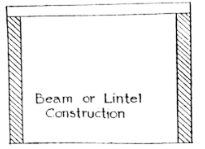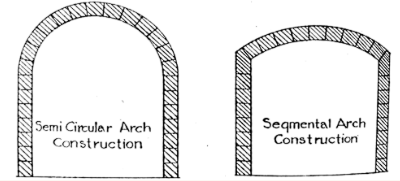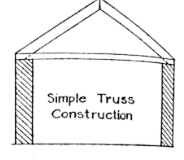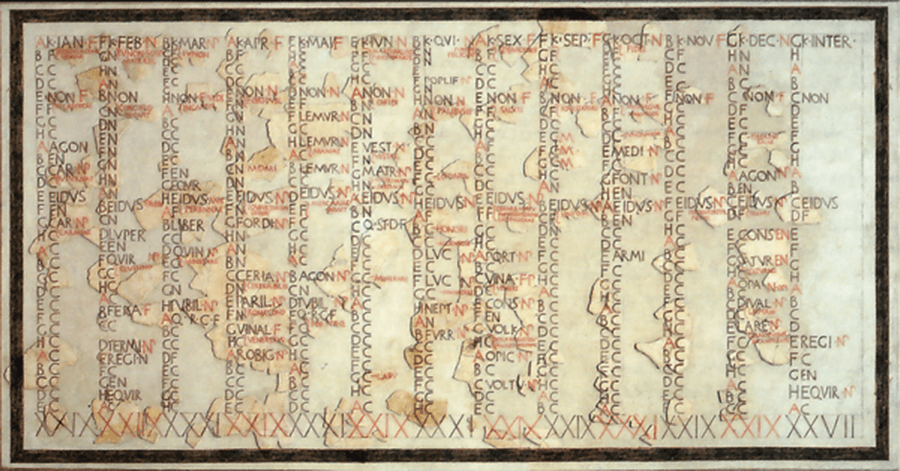2.1 An Introduction to Design History
1/26
There's no tags or description
Looks like no tags are added yet.
Name | Mastery | Learn | Test | Matching | Spaced |
|---|
No study sessions yet.
27 Terms
Roof Forms
Simple houses are surmounted by a roof for shade and protection from the elements. Walls at the edges support them but would also need additional supports to hold up its span. The three most common roof forms are:
Post and Lintel
Arches
Trusses
Post and Lintel
The most basic form of construction involves a long, spanning member (the beam) made of either wood, stone, metal, or any other material held up by two supports (the post).

Arches
These are structural supports whose span is supported by a curve. Each side of the arch rises from the top of a wall and meets the curve from the other wall at the center. The curve can be semicircular, a portion of the curve (segmental), or of other configurations.

Trusses
These are an assemblage of beams forming triangles, used to span greater distances when traditional lintel systems are no longer sufficient. Two beams are placed on a slat and meet in the middle. They are tied together at their lower ends by a tie beam.

Pediment Forms
Pediments refer to the styles of the space that forms the gable of a low-pitched roof and that is usually filled with relief sculpture in classical architecture. Triangular, segmental, broken, and scrolled are some of the most common types.
Triangular Pediment

Segmental Pediment

Broken Pediment

Scroll Pediment

Column
Posts are isolated supports that hold up the beams/ lintels. When the design of these posts was later formalized by ancient civilizations (in stone as opposed to wood)
capital
top molding of the column, often ornamented,

base
block placed at the bottom of the column

shaft

Types of Curves
Mechanical, Mathematical, Free
Mechanical curves
These curves are formed using a compass and consist of any part or all of a circle. The point where the curve starts is called the “spring point,” while the line that connects the two points where an arch commences is called the “spring line.”
spring point
The point where the curve starts
spring line
line that connects the two points where an arch commences
Mathematical curves
These are curves taken from conic sections, namely the ellipse, a parabola, and a hyperbola, as well as spirals and helixes.
Free curves
These curves are freehand sweeps and cannot be classified as either mechanical or mathematical.
The Influence of Period Styles
These refer to the generally recognizable trends or characteristics of fine or utilitarian art produced by one group during a specific time. They are often influenced by several external factors, such as:
Availability of materials
Climate
Geography
Socioeconomic condition of the population
Religion
Trade and commercial opportunities
Historical or political events
Scientific innovations or discoveries
The Gregorian Calendar
The Gregorian calendar is the calendar used in most of the world
named after Pope Gregory XIII, who introduced it in October 1582

Prehistory
refers to history before the invention of writing. This period chronicles the events and the culture of human civilization during the Stone Age until the advent of permanent settlement at the end of the Ice Age.
Ancient/ Antiquity
refers to the period documenting the rising empires of the Mesopotamian plains, all the way to the histories of ancient Greece and Rome. The latter two civilizations and their contributions to European, albeit world culture, are also collectively referred to as the Classical period or Classical Antiquity.
The Middle Ages
roughly spanning about 1,000 years, this period in history deals with the upheavals in Europe right after the collapse of the western Roman empire, including the spread of Christianity and Islam, the plague, and the string of events that would eventually give rise to positive changes and development in European society, giving rise to the Renaissance.
Renaissance
was a rebirth of interest in ancient Greek and Roman culture. It was also a period of economic prosperity in Europe, particularly in Italy and in Northern Europe. Religion and royalty were the preeminent powers of the times, although freethinkers eventually challenged their influence. During this period, the Scientific Revolution began, and observation replaced religious doctrine as the source of our understanding of the universe and our place in it.
Early Modern
deals with the expanding empires of Europe and their exploration of regions beyond their shores. It includes the Age of Exploration and subsequent colonization. Wealth and influence changed hands and sides, wherein the rising power of the middle class came to the fore.
Modern
the drive of commerce, aided by the age of industrialization, brought in the change in the times